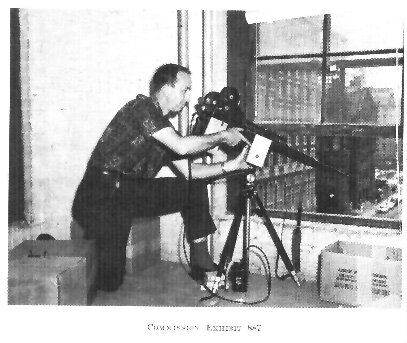 Dark Corners Menu |
 "Sniper's Nest" Menu |
 Dark Corners Menu |
 "Sniper's Nest" Menu |
by Allan Eaglesham
|
3. IMPLICATIONS
3.1. Sniper Position The August/September 1993 issue of U.S. News & World Report contained an eleven-page article by Gerald Posner titled The Sniper's Nest. It was an adaptation from Posner's book Case Closed (Random House, 1993), and included a sketch of a sniper at the southeast corner of the sixth floor of the TSBD (Figure 22). The illustration was true to the official "sniper's nest," with the eastern-most stack of cartons absent and the window-sill box positioned in mid-window. Only the upper body of the shooter was illustrated, and he appeared to have ample space in which to maneuver. The sketch was not to scale, however. Using the length of the Mannlicher-Carcano as reference, Figure 23 illustrates how cramped a gunman would actually have been; the rifle is at an angle of 45 degrees to the south wall of the TSBD, approximately the trajectory for a hit at Zapruder frame 313 [15] when President Kennedy was struck in the head. The sniper, as depicted in Figure 23, could not have moved significantly to his left, i.e. to the south, because of vertical pipes near the edge of the brick wall (cf. Figures 1, 4 and 11). In contrast, Posner's sketch indicated that a sniper would have been comfortably to the west of the pipes (Figure 22). |

| Figure 23 includes loosely stacked cartons, mainly three-high, to the north of the "sniper's nest" (also seen in Figure 24). These would have concealed a crouched gunman from view from the sixth floor as a whole -- the tightly stacked cartons closer to the window were not necessary for coverage; in the sketch (Figure 23), the loosely stacked carton are positioned approximately, with input from Tom Alyea. Alyea has a firm recollection of a clear passage between the two distinct sets of stacked cartons (termed "barricades" by him) and of a clear area west of the "sniper's nest" up to the next window on the south wall. Additional boxes to the north and west of the "sniper's nest" that are in Figure 24 (with and above asterisks), were those removed from the L-shaped configuration by Detective Studebaker. |


Figure 24. Same view as Commission Exhibit 503.
("F" and "A" denote the approximate locations of Captain Fritz and Tom Alyea when the
police officer signaled that he had discovered the cartridges in the "sniper's nest.")
Commission Exhibit 887 (Figure 25) provides a convenient reference for appraising the space available to a sniper. The photographer's left foot was in contact with the east wall, and comparison shows that his right leg, knee to the floor, was in the location of the box marked with an asterisk in Figure 23. In Figure 23, if the shooter moved to the west, even by just a few inches, he would lose elbow room because of the wall of cartons to his right. In Figure 25, the rifle is several inches higher than the "rifle-support" boxes in Figure 12, further suggesting that the sniper position in Figure 22 is unlikely.
 Figure 25. Commission Exhibit 887. Notes |
| Previous Section | Next Section |
